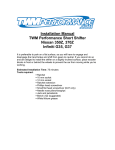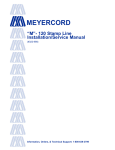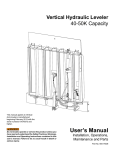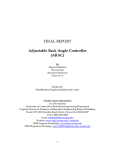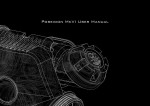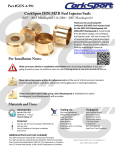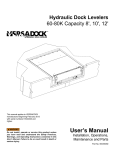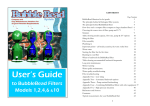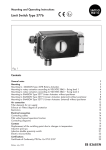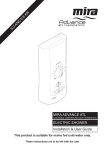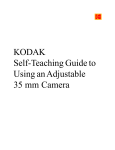Download PD Pump Systems
Transcript
PD Pump Systems NESLAB P/N 000878 Rev. 08/15/96 Service Manual 1 Contents General Information Identification .................................................................................................................... 2 Application ...................................................................................................................... 3 Flow diagram .................................................................................................................. 4 Theory of Operation ........................................................................................................ 5 Pressure / flow curve ....................................................................................................... 6 Fluids .............................................................................................................................. 7 Wetted parts ................................................................................................................... 7 Troubleshooting No Flow .......................................................................................................................... 8 Pump Noise .................................................................................................................. 10 Low Flow and/or Pressure ............................................................................................ 12 Leaks ............................................................................................................................ 13 Pressure gauge always zero ......................................................................................... 14 Pressure gauge incorrect .............................................................................................. 15 Motor operation............................................................................................................. 16 Motor Temperature ....................................................................................................... 17 Component Repair and Replacement Pump Replacement ...................................................................................................... 18 Motor Replacement ...................................................................................................... 20 Coupling ....................................................................................................................... 22 Pressure Gauge Replacement ...................................................................................... 24 Pressure Gauge Orifice ................................................................................................ 25 Check Valve ................................................................................................................. 26 Testing the Check Valve .......................................................................................... 27 Replacing the Check Valve ...................................................................................... 28 Check Valve Cross-section ...................................................................................... 28 Relief Valve Adjustment (External) ................................................................................ 30 Capillary Tube............................................................................................................... 31 Adjustments and Maintenance Priming ......................................................................................................................... 32 Relief Valve (Internal) .................................................................................................... 33 Pressure Adjustment ..................................................................................................... 34 Coupling Lubrication ..................................................................................................... 37 Motor Lubrication .......................................................................................................... 38 Strainer - PD1 .............................................................................................................. 40 Strainer - PD2 .............................................................................................................. 42 Parts List ........................................................................................................................... 44 2 Figure 1 Identification This section is for maintenance of positive displacement pumps manufactured by PROCON®. These are brass pumps which match one of the above drawings. 3 Application The pump type used in a recirculating chiller system is determined by the requirements of flow and pressure. This chart illustrates which pump family is suitable for various combinations of flow and pressure. If the pump system does not deliver the required flow and pressure on initial installation, the requirements should be compared to the catalog pump curves to confirm the pump is correctly sized to the application. If the pump system has delivered the required flow and pressure in the past, and the application/installation is unchanged; it is safe to assume a degradation in performance has occurred and can be corrected. Figure 2 4 5 Figure 3 Theory of Operation The PD (Positive Displacement) pump is a type of rotary vane pump, known as a carbonator pump due to its widespread use in the beverage industry. Four vanes are captive to a rotor which connects to the motor shaft. The rotor spins inside a liner. The rotor and liner are on different centers, providing an eccentric cavity. Opposing vanes are connected by push rods. As one vane is pushed into the rotor slot by the approaching liner, the opposing vane is pushed out of the rotor slot, maintaining firm contact with the retreating liner. Figure 4 Fluid enters the liner cavity and is trapped between two vanes. As the vanes rotate inside the liner, the eccentric alignment gradually decreases the volume available to contain the fluid. When the rotating trapped fluid finally encounters an outlet, it is squeezed out at high pressure. The result is a consistent flow rate, essentially regardless of system pressure. The pump curve approximates a straight line. Thus, this pump family is designed to deliver low flow rates and high pressures. Disassembly of the pump is not recommended. Restoration of performance is unlikely due to high machining tolerances required. Any internal pump failure should be resolved by replacing the pump. The manufacturer (Procon®) accepts removed pumps for rebuilding. 6 Figure 5 7 Fluids This is a list of some typical fluids which may be used in a PD pump system. Glycol, ethylene - up to a 50% concentration in water. Laboratory or reagent grade is typically used. Automotive antifreeze is not recommended. Glycol, propylene - up to a 50% concentration in water. Laboratory or reagent grade is typically used. Automotive antifreeze is not recommended. Water, deionized - up to a resistivity of 1.8 megohm/cm. Water, single distilled Water, tap Wetted Parts The following materials are in contact with the circulating fluid in a PD pump system. PVC Copper Bronze Brass Stainless Steel Teflon® thread sealing tape Nickel-plated copper Carbon-graphite pump vanes and liner 8 Troubleshooting chart - No Flow 9 Figure 6 Troubleshooting chart: No Flow (continued) Figure 6a 10 Troubleshooting chart: Pump Noise Figure 7 11 Troubleshooting chart: Pump Noise (continued) Figure 7a 12 Troubleshooting chart: Low Flow and/or Pressure Figure 8 13 Leaks The flange area of the pump has assembly holes at the top and the bottom. Fluid leaking out of either hole indicates a shaft seal failure. The seal has a limited ability to seat around imperfections. If this is a new pump, allow it to run for 24 hours and re-inspect. A continuous leak will require pump replacement. Field replacement of the shaft seal is not practical. Certain fluids will deteriorate the pump shaft seal. Highly deionized water will leach ions out of the seal material, causing it to lose flexibility. This will cause leaks. Deionized water must be used with caution, and with monitoring of the deionization level. See FLUIDS for further details. Figure 9 14 Troubleshooting chart: Pressure gauge always zero Figure 10 15 Troubleshooting Chart: Pressure gauge incorrect Figure 11 16 Troubleshooting Chart: Motor operation Figure 12 17 Motor Temperature Many times users are concerned that motors are operating too hot. It should be understood that a properly-loaded motor will reach a shell temperature hot enough to cause burns if touched. This is a normal condition. The nameplate of the motor may have a specification for RISE. This is the temperature the shell of the motor will attain above ambient (inside the case of the machine, not room ambient). For example, if the nameplate RISE is 90°C (194°F), and the motor is operating in a 30°C (86°F) ambient; the shell of the motor may attain 120°C (248°F) which is well above the boiling point of water! In the absence of a RISE specification, the nameplate will specify the motor as Class A or B. Class A motors may not exceed 105°C (221°F). Class B motors may not exceed 130°C (266°F). Single-phase motors used by NESLAB are all internally thermally protected.* The motor nameplate should carry the legend Thermally protected. If the motor is still running, it is below the trip point of the thermal protector; and therefore is within operating range. If the motor is indeed too hot, it will cycle on and off on the thermal protector - and flow will be observed to stop and start. Internal thermal protectors are all automatic reset. The motor will restart without warning when the thermal protector resets. The thermal protector has a wide hysteresis (dead band), and the motor must cool down almost to ambient before reset. This may take considerable time due to the mass of the motor. * One exception: Certain blue IMOFA-brand motors used in CFT units for export to Europe have no internal thermal protector, but rather an external circuit breaker mounted in the control box. 18 Pump Replacement Tools required: Bucket Nut driver 5/16" Wrench Adjustable Bench Vise Torque-type screwdriver, capable of 30 in/lb (170 cm/kg) Torque-type wrench, 5/16", capable of 50 in/lb (280 cm/kg) 1. Disconnect unit from line voltage. 2. Drain the fluid from the system. 3. Loosen the hose clamp on each of the pump fittings using a 5/16" nut driver as soon as practical. Hose removal will be much easier if the hose is allowed to relax for 10-15 minutes after each clamp is loosened. 4. Loosen the V-band clamp and slide it up against the motor. 5. Pull the hoses off the hose fittings. 6. Remove the pump from the unit with the fittings intact. 7. Place the pump in a vise and remove the fittings from the pump. They can generally be unscrewed without desoldering. Don’t squeeze the round part of the pump in the vise! The vise should hold the pump by the square boss area just below the fittings. 8. Install the fittings in the new pump using Teflon® tape as a sealant. Support the pump body in a vise or use a backup wrench. 9. If soldering must be done on the fittings, do so before installing them in the pump. Solder balls dropping into the pump will destroy the vanes. If soldering must be done to the fittings while on the pump, orient the pump so the openings face downwards. Always use a soft solder: either 50/50 or 95/5 is acceptable. 10. Check the lubrication cup on the motor shaft. Refer to COUPLING LUBRICATION for details. 19 11. Check that the slot in the motor shaft is sharply rectangular, without undue wear. The motor should also be replaced if its slot is worn. 12. Be aware the coupling is not symmetrical! The wide end fits in the motor and the narrow end fits in the pump. 13. Add some circulating fluid into the pump inlet fitting now to assist in priming later. 14. Ensure mating flanges of both pump and motor are clean and free of burrs that may have occured during handling. File any burrs smooth. Remove and discard the foam shipping strip from the coupling if it is present. 15. Attach pump to motor, guiding coupling into place. 16. Observe that flanges mate squarely. Tighten V-band clamp to 15 - 30 in/lbs (85 - 170 cm/kg) of torque. 17. Install hoses onto fittings. If they do not slide on easily, apply a small film of liquid hand detergent to the hose barbs. 18. Torque hose clamps to 50 in/lbs ( 280 cm/kg). NOTE: Nylon-reinforced hose tends to cold-flow, so the clamps will need to retorqued later. (The hose clamps do not actually loosen, but rather the hose O.D. decreases!) It is best to give them a final torqueing just prior to leaving the job site. Explain to the customer that a further torqueing may be required the following day - and that a drip developing at a hose clamp is a result of cold-flow and not poor workmanship. 20 Motor Replacement Tools required: Wrench, 1/2" open-end or combination Nut driver, 5/16" Torque wrench, capable of 30 in/lb (170 cm/kg) NOTE: The motor may be replaced without opening the fluid system. Draining the unit is not necessary. Ensure the unit is physically disconnected from line voltage before attempting motor replacement. Turning the unit’s power switch off is not adequate to provide safety. 1. Loosen the V-band clamp between the pump and the motor. Pull the pump away from the motor to separate them. 2. Remove the nuts from the motor mounts using a 1/2" wrench. If the top nuts are not accessible, remove the bottom nuts by reaching under the shelf. The motor will come out as long as one nut is removed from each motor mount ... it doesn't matter whether from the top or bottom. 3. Jockey the motor off the shelf so the electrical connection box is accessible. Remove the cover. 4. Disconnect wires, noting which terminals are used. Remove old motor. 5. If a bronze pump coupling is being used between the pump and motor, install a lubrication cup on the motor shaft as described in COUPLING LUBRICATION. This step is not required if a nylon coupling is used. 6. Turn the shaft of the new motor a few revolutions by hand. 21 7. Connect wires to the new motor. Position new motor in the unit. Eye protection must be worn during this step. 8. Temporarily provide power to the motor. Jog the motor briefly and observe that the direction of rotation matches the arrow on the front of the pump. The motor shaft should turn clockwise as viewed from the pump end. 9. Check that the slot in the pump is sharply rectangular, without undue wear. 10. Be aware that the coupling is not symmetrical! The wide end fits in the motor and the narrow end fits in the pump. 11. Ensure mating flanges of both pump and motor are clean and free of burrs. 12. Join pump and motor, guiding coupling into place. 13. Check that flanges align tightly. Tighten V-band clamp to 15 - 30 in/lbs (85 - 170 cm/kg) of torque. 22 Coupling Types 1. BRONZE COUPLING The bronze coupling is a sacrificial coupling. It is a softer metal than either the steel pump bearing race or the steel motor shaft. The coupling will wear to avoid wearing these more critical components. The coupling is also intended to shear in two in the event the pump stops unexpectedly due to foreign matter in the pump, or seizure. This protects the motor by unloading it and allowing it to continue turning. A new coupling is supplied with replacement PD pumps. It is temporarily held in place with a soft foam strip. This strip should be removed and discarded. The coupling is slightly asymmetrical. The wide tab fits in the motor, and the narrow tab fits in the pump. NESLAB adds a lubrication cup to the motor shaft on PD pumps using bronze couplings. This has been found to extend the useful life of the coupling. See COUPLING LUBRICATION. Figure 13 23 Coupling Types (continued) 2. NYLON COUPLING Some PD pumps use a straight nylon coupling. This coupling is slightly tapered. The wide end fits in the motor, and the narrow end fits in the pump. It does not require the lubrication cup used with the bronze coupling. The bronze and nylon couplings are interchangeable. There is no particular advantage to using one or the other. 3. CAPTIVE COUPLING Older PD-1 pumps have a captive tab emerging from the pump which is actually the end of the rotor shaft. This tab mates directly with the motor slot. There is no removable coupling on these pumps. The current PD-1 pumps have the same removable coupling (bronze or nylon) which is used on the PD-2 pumps. The captive coupling pumps are no longer available and may be directly replaced by the removable coupling style pumps. 24 Pressure Gauge Replacement 1. Disconnect the unit from line voltage. 2. Remove fitting nut from the rear of the adapter fitting. The fitting nut will be held captive to the capillary tube by the ferrule. 3. Remove the adapter fitting. 4. Remove clamp bracket(s). 5. Pull the gauge out of the panel hole from the outside. 6. Apply Teflon® tape to the nipple of the new gauge. 7. Mount the new gauge using the clamp bracket(s). 8. Install the adapter fitting. 9. Retighten fitting nut. (Do not use Teflon® tape here). 10. Turn unit on and check for leaks. Figure 14 25 Pressure Gauge Orifice The mini style pressure gauge, 1 1/2 in ( 4 cm) diameter, has a small orifice plate between the gauge nipple and the diaphragm. This is intended to dampen any needle vibration. The orifice can become clogged by a small piece of dirt. If this happens, the gauge will read zero all the time. Before disassembly, confirm that the needle is on the correct side of the stop pin. If incorrect, the gauge has been destroyed by overpressure and will require replacement. Figure 15 To clean the orifice, remove the adapter fitting from the gauge. Insert a small needle or similar probe into the gauge nipple. Locate the orifice and twirl the needle in the opening. This should push any debris inside the gauge where it will be trapped out of trouble. (System pressure will prevent any such trapped dirt from "backing up" into the orifice). Reconnect fittings and test the gauge. Figure 16 26 Check Valve (Installed on HX units only) The check valve is intended to keep the tank from siphoning dry if the hose is removed from the return fitting. The valve is located upstream from the return fitting. There are two styles of checkvalves used. The mechanism of the style shown in Figure 17 consists of a Teflon® seat on a weighted hinged flapper; the one shown in Figure 18 is of a spring-loaded metal-to-metal design. The mechanism is accessible through the access cover. This need not be opened under normal use, as there is no periodic maintenance required on either style checkvalve. Figure 17 Check Valve 27 Figure 18 Testing the Check Valve 1. Remove the hose from the return fitting. (If the return line drains at this point, the valve is stuck open). Figure 19 2. Insert a hose from a pressurized gas source (such as nitrogen or compressed air) into the return fitting. Cup your hand around the fitting to provide a "seal". 3. Apply a burst of gas into the fitting. You should hear a clickclick sound as the seat flops up and down. Note: If there is fluid trapped in the return line between the valve and the tank, it will drain out during this step. 28 Replacing the Check Valve NOTE: Any soldering to the check valve body must be done carefully to avoid melting the Teflon® seat. 1. Open the service access cover. 2. Insert a bent wire such as a coat hanger to pull the seat open and secure it. This keeps the Teflon® from contacting the hot valve body. 3. Wrap the valve body with a damp rag. 4. Use a low temperature solder such as 95/5 or 50/50. Use a hot flame and work quickly. 5. Do not release the seat until the body is cool. CHECK VALVE CROSS-SECTION Figure20 29 Ball and Spring Type Check Valves Older check valves use a mechanical ball and spring arrangement. Performance of this type can usually be restored by polishing the ball using Scotch-Brite® or a similar abrasive pad. Repair of this type, beyond cleaning, is not practical. If a failed valve of this type is found, it should be replaced by the current Teflon® seat type. Lubrication A small amount of molybdenum lubricant (see Coupling Lubrication) on the access cover threads will assist in sealing and provide easier future service. 30 Relief valve adjustment (external) Leaks occurring at the locknut generally may be solved by tightening the locknut. The locknut serves two functions: It prevents the adjustment stem from moving, and it tightens against the packing gland inside the valve to prevent leaks. Leaks occurring at the large nut (labelled "DO NOT ADJUST" in the diagram) should be solved by replacing the valve. Replacement of the valve is done by removing any hoses, then transferring the fittings to a new valve. Teflon® tape should be used on the threaded fittings. Replacement of the valve will require the system pressure to be reset. Refer to ADJUSTMENTS and MAINTENANCE: PRESSURE ADJUSTMENT for details on setting the system pressure. Relief valve adjustment Figure 21 31 Capillary Tube The pressure gauge is connected to the pump discharge line by a capillary tube of 0.075" (0.191 cm) I.D. (Inside Diameter). The length is determined by measuring the distance of the path from the discharge line to the pressure gauge and adding 27" ( 68 cm ). This additional length will allow a 3 turn coil of approximately 3" ( 7.6 cm ) diameter to be included. This coil will dampen any needle vibration and allow future service. TIP: A 3" (7.6 cm) diameter coil may be formed easily using an aerosol can as a winding form. The capillary tube I.D. 0.075" (0.191 cm) was chosen because the O.D. (Outside diameter) of 0.125" (0.32 cm ) provides a snug fit in the adapter fitting. The gauge indicates system back pressure, not pump capacity. A unit connected to a low back-pressure system (parallel manifolds, or short lines of large diameter) may indicate 0 or a very low pressure. In other words, the gauge indication reflects reflects system demand, not pump supply. 32 Priming The pumps are self-priming only if plumbed in a flooded-suction configuration, i.e. the fluid flows continually downhill from the tank to the pump inlet. NESLAB CFT and HX applications are not plumbed flooded-suction, so priming may not be automatic. If flow does not start immediately, shut the unit off. Remove the fitting nut from the rear of the adapter fitting on the pressure gauge. (The fitting nut is held captive to the cap tube by a ferrule.) This allows the cap tube to become a vent for the discharge line, providing an escape path for air trapped in the pump. Place a rag over the end of the cap tube. Start the unit. When fluid is observed flowing steadily from the cap tube, reseat it in the adapter fitting and tighten the fitting nut. When installing a new pump, add a small amount of fluid to the inlet of the pump during installation to assist priming. See PUMP REPLACEMENT for details. Pressure Gauge Fittings Figure 22 33 Relief Valve (Internal) The relief valve built into the pump temporarily protects against dangerous overpressure. The relief valve is set at the pump factory and confirmed at NESLAB. The relief valve setting appears stamped in the brass as shown. (The illustration shows the position of the stamping only - your actual value may differ). The flow will fully bypass from the outlet to the inlet at the specified relief valve setting. The relief valve actually begins to crack open and allow bypass flow approximately 50 PSI (345 kPa) below the stamped relief valve setting. Turning the pressure adjustment screw clockwise will increase the relief valve setting. NESLAB supplies an additional external relief valve, set to a lower setting, to provide primary pressure control. The internal relief valve is a safety feature and should not be relied on to provide primary pressure control. Changing the setting on this internal relief valve is not recommended. See PRESSURE ADJUSTMENT for details on balancing the settings of both internal and external relief valves. Figure 23 34 Pressure Adjustment The fluid system contains two relief valves: An internal one in the pump, and an external one on the pump discharge line. Because of their ability to interact, adjustment must be done in a certain sequence. Figure 24 35 1. Turn unit off. Locate the external relief valve. Loosen the locknut. Turn the threaded stem all the way in (clockwise). This manually closes the valve by setting it to an infinite value. External Relief Valve Figure 25 2. If the unit is not plumbed to an application, install a loop of hose between the supply and return fittings. Turn unit on. NOTE: The external relief valve may drip while the locknut is loose. This is normal. 3. CFT units: Crimp the loop of hose flat using a pair of visegrips. HX units: Turn flow control valve completely clockwise if a round handle, or fully - if a lever handle. The pressure gauge should rise to a high value. It is now indicating the internal relief valve setting. Internal Relief Valve 36 Figure 26 Internal Relief Valve Adjustment 4. Remove the acorn nut on the side of the pump. Adjust the pump pressure adjustment screw (under the acorn nut) until the gauge indicates the value stamped on the pump. If no value is shown, adjust to 90 PSI (620 kPa) . Turning the screw CW will increase the pressure setting. Replace the acorn nut. Internal Relief Valve Figure 27 External Relief Valve Adjustment 5. Back out the threaded stem on the external relief valve (CCW). As the setting drops below the internal valve setting, the gauge will now indicate the external valve setting. Continue until the gauge indicates 80 PSI ( 550 kPa ) or desired setting. Tighten the lock nut. 6. The external relief valve is intended for coarse pressure limiting, not regulation. For precise pressure regulation, an external bypass type regulator is recommended. NOTE: The minimum pressure achievable using the provided external relief valve is about 35 - 45 PSI ( 240 - 310 kPa). If lower operating pressures are required, the addition of an external bypass-type regulator is recommended. NESLAB sells various EPR (External Pressure Regulator) kits for this purpose. Contact a NESLAB sales representative37 for information. Coupling Lubrication NESLAB has found that providing lubrication to the bronze coupling will extend its useful life. NESLAB installs a heat shrink sleeve on the motor shaft as a cup to contain the lubricant. If this cup is still intact, it should be reused. If the cup is frayed or otherwise damaged, it should either be replaced or removed completely. Obtain a piece of ¾" ( 2 cm ) heat shrink tubing. Cut the piece to 1.5" ( 4 cm ) long. Fully seat the tubing on the motor shaft. Heat evenly with a heat gun. Insert a small glob (pea-sized) of lubricant. NESLAB uses a molybdenum-based lubricant with the trade name NEV-R-SEEZ®. This lubricant is intended primarily for use in automotive exhaust systems to allow future disassembly, and is commonly available at automotive supply stores. The grease base will eventually dry up and leave the molybdenum behind as a lubricant. The intent is to provide lubricant between the coupling and the motor shaft. Do not lubricate between the coupling and the pump slot. The nylon coupling does not require lubrication. 38 Motor Lubrication Figure 28 PD pumps are generally powered by sleeve-bearing carbonator type motors, NEMA type 48YZ**. These motors must be run on a horizontal-shaft orientation, due to the internal oil reservoir. A wick runs from the reservoir to each bearing. The motor will have either one or two lubrication ports, depending on the manufacturer. A good source of oil is the 3-IN-ONE® brand squeeze cans manufactured by Boyle-Midway, Inc. It should be available at hardware stores or electrical supply houses. Figure 29 **exception: Blue IMOFA-brand motors and grey MAC-brand motors are ball bearing and require no periodic lubrication. 39 The motor should be oiled periodically in accordance with the nameplate directions. In the absence of legible lubrication instructions, add 30 - 35 drops of SAE 20 non-detergent oil to each oil port. Use the following table as a frequency guide: Duty Oiling frequency Continuous Annual Regularly Every 2 years Occasional Every 5 years Table 1 Figure 30 40 Strainer - PD1 All PD pumps require a 100-mesh strainer on the inlet side of the pump. Particles that are trapped are of sufficient size to destroy the vanes of the pump. Never run the pump with a missing or damaged strainer screen. The PD1 pump has an internal strainer screen. Figure 31 41 Periodic cleaning of the screen is necessary. The screen may be removed without significant fluid loss. Turn the unit off and disconnect from the power source. Have a clean rag handy which has been dampened and twirled into a pointy shape. Remove the strainer cap using an open end or socket wrench. Pull out the screen and quickly stuff the rag into the opening. Some spillage will be unavoidable. If a helper is available, the helper could hold the rag tightly in place while you clean the screen. (You can temporarily reinstall the strainer cap finger tight.) The debris will be inside the screen. Clean the screen under running water. A toothbrush is a handy tool for cleaning. Trim the bristles to 1/2 length for a PD1 screen. An alternative is to take a coarse paper towel (the brown roll type), dampen it and twist it into a spiral. Pull it through the screen several times, turning it as it passes. Inspect the screen closely for damage - particularly holes. It is advisable to keep a spare screen on hand. The spare may be quickly substituted for the dirty screen, minimizing downtime and fluid loss. Then the dirty screen may be cleaned at your leisure and retained as the spare for next time. 42 Strainer - PD2 All PD pumps require a 100-mesh strainer on the inlet side of the pump. Particles that are trapped are of sufficient size to destroy the vanes of the pump. Never run the pump with a missing or damaged strainer screen. The PD2 pump has an external strainer screen, located on the pump inlet line. It may be a brass body type (Figure 32), a plastic type (Figure 33), or it may be a basket type inside the reservoir on HX units. Figure 32 Figure 33 43 Periodic cleaning of the screen is necessary. The screen may be removed without significant fluid loss. Turn the unit off and disconnect from the power source. Have a clean rag handy which has been dampened and twirled into a pointy shape. Remove the strainer cap using an open end or socket wrench. Pull out the screen and quickly stuff the rag into the opening. Some spillage will be unavoidable. If a helper is available, the helper could hold the rag tightly in place while you clean the screen. (You can temporarily reinstall the strainer cap finger tight.) The debris will be inside the screen. Clean the screen under running water. A toothbrush is a handy tool for cleaning. It will fit nicely inside the PD2 screen. An alternative is to take a coarse paper towel (the brown roll type), dampen it and twist it into a spiral. Pull it through the screen several times, turning it as it passes. Inspect the screen closely for damage - particularly holes. It is advisable to keep a spare screen on hand. The spare may be quickly substituted for the dirty screen, minimizing downtime and fluid loss. Then the dirty screen may be cleaned at your leisure and retained as the spare for next time. A small amount of molybdenum lubricant (See COUPLING LUBRICATION) on the PD2 strainer cover threads will assist sealing and provide easier future service. 44 Table 2 Part Number 012869 009142 008123 008124 004185 013123 008445 008295 008125 008126 008120 009057 009212 009083 009200 008423 008142 008576 008205 008159 008143 008181 008155 008694 009058 009347 013459 009384 004626 008899 Parts List Description Adapter Fitting for pressure gauge Check vlave Clamp, V-band Coupling, Bronze 90 degree Coupling, Nylon Heat Shrink, ¾" diameter Motor mount Motor, ½ HP, 115/230v Motor, 1/3 HP, 115v Motor, 1/3 HP, 208-220v Motor, ¼ HP, 115v Pressure gauge, 1.5" panel mount, 0-100 PSI Pressure gauge, 2" panel mount, 0-100 PSI Pressure gauge, 2" panel mount, 0-160 PSI Pressure gauge, 2" stem type, 0-100 PSI Pump, PD1, brass, bronze coupling. Replaced by 008576 Pump, PD1, brass, captive coupling. Replaced by 008423 Pump, PD1, brass, nylon coupling Pump, PD1, brass, optional hi temp Viton® seal Pump, PD1, stainless steel Pump, PD2, brass Pump, PD2, optional hi temp Viton® Seal Pump, PD2, stainless steel Relief valve, external Relief valve, external. Replaced by 008694 Strainer assembly, bronze Strainer screen, PD1 replacement Strainer screen, PD2 replacement Strainer, POLYP 100 mesh Check Valve, ½", SWT, BRZ, WTR 45 Usage PD1 Usage PD2 X X X X X X X X X X X X X X X X X X X X X X X X X X X X X X PD Pump Systems NESLAB P/N 000878 Rev. 08/15/96 Service Manual 46















































